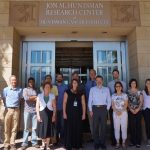Protein kinases are a family of 518 human proteins which receive and transmit information within the cell, often from one kinase to another. The information flow within the network governs all aspects of cell biology, including cell growth, movement and survival. Not surprisingly, cancer very often re-wires kinase activity and connectivity to support its uncontrolled growth and metastasis. Indeed, protein kinases are the most commonly mutated protein family in human cancer. Protein kinases are also exceptionally ‘druggable’ and constitute the most tractable class of new therapeutic targets. Two significant challenges exist. First, we know a great deal about very few protein kinases. There is no doubt that targeting understudied kinases in cancer will benefit patients, but what kinases and for which patients? Second, several kinase inhibitors have proven immensely effective in certain cancers, however not all patients respond and for those that do respond, resistance inevitably emerges. We now know that cancer reprograms the kinase network to bypass chemotherapy. To tackle these challenges, we have developed a new technology that allows us to identify and quantify the activity of nearly all kinases in a single experiment. This allows us to comparatively study kinase activity in normal cells and in cancer cells, in chemotherapy-sensitive and resistant cancers, and in tumors before and after relapse. We hypothesize that the responsiveness of cancer to targeted therapy is determined by the baseline activity of specific kinases and the nature by which these activities adapt to therapeutic challenge. We will test this hypothesis in tumors of the lungs and head and neck. Together, our experiments may lead to the identification of specific kinase activities which: 1) predict cancer disease progression, 2) predict response to therapy, and 3) suggest new and rationally designed therapeutic strategies for patients with naïve and relapsed cancer.
The V Foundation for Cancer Research Expands Executive Leadership Team
Read more













